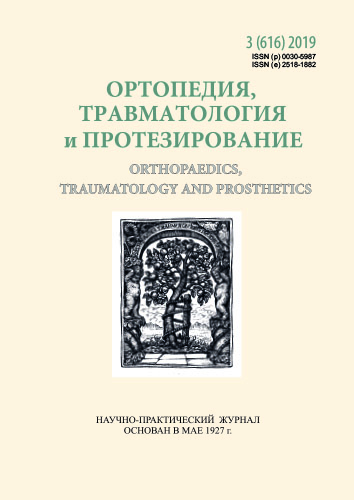Surgical treatment of solitary bone cysts in children using alloimplants
DOI:
https://doi.org/10.15674/0030-59872019373-78Keywords:
solitary bone cyst, children, bone implants, bone grafting, surgical treatmentAbstract
One of the traditional methods for treating solitary bone cysts (CCMs) is edge resection and defect replacement with bone or ceramic implants. Materials based on allogeneic bone after various types of processing that combine optimal properties for osteoregeneration may be promising.
Objective: to evaluate the results of surgical treatment of children with CCMs using bone alloimplants for plastic surgery of post-resection defects.
Methods: the results of examination and treatment of 11 patients (8 boys, 3 girls, age from 5 to 16 years) were analyzed. The diagnosis was established on the basis of the totality of the clinical manifestations of the disease, data from laboratory tests, X-ray and pathomorphological studies. The distribution according to the localization of the pathological focus: the proximal femur — 6 (54.5 %), the humerus — 2 (18.2 %), the heel — 2 (18.2 %), pubic — 1 (9.1 %). Indications for surgical treatment: the presence of a massive lesion of bone tissue in the loaded area, a high risk of pathological fracture, a pronounced longterm pain syndrome. All patients underwent regional resection and chemical processing of CCMs; defects were filled with osteoplastic material.
Results: according to x-ray, bone remodeling in the surgical area occurred in 6–12 months. after operation. After 12–18 months the bone structure of the patients was corresponded to normal without or with plastic residues. Infectious complications, recurrences of the pathological process and repeated fractures were not observed, pain was absent, motor activity was restored.
Conclusions: the studied osteoplastic material of allogeneic origin can be recommended for use in the surgical treatment scheme for CCMs in children for plastic surgery of post-resection defects to restore bone structure.
References
- Levitsky, A. F., & Golovatyuk, D. V. (2013). Bone cysts in children (etiology, diagnosis and treatment). Chronicle of Traumatology and Orthopedics,1 (2), 229–236. (in Ukrainian)
- Pozdeev, A. P., & Belousova, E. A. (2017). Solitary bone cysts in children. Orthopedics, traumatology and reconstructive surgery of children, 5 (Issue 2), 65–74. doi:10.17816/PTORS5265-74. (in Russian)
- Verdiev, F. V. (2014). Bone cysts in children and adolescents (literature review). Orthopedics, traumatology and prosthetics, 2, 135–140. doi:10.15674/0030-598720142135-140 (in Russian)
- Kim, M., Joo, S., & Jung, S. (2018). The role of fractures on pathologic bone in healing of proximal humerus unicameral bone cysts. Journal of Orthopaedic Surgery, 26 (2), 230949901877836. doi:10.1177/2309499018778366
- Kim, H. S., Lim, K. S., Seo, S. W., Jang, S. P., & Shim, J. S. (2016). Recurrence of a unicameral bone cyst in the femoral diaphysis. Clinics in Orthopedic Surgery, 8 (4), 484. doi:10.4055/cios.2016.8.4.484
- Lee, S. Y., Chung, C. Y., Lee, K. M., Sung, K. H., Won, S. H., Choi, I. H., & Park, M. S. (2014). Determining the best treatment for simple bone cyst: a decision analysis. Clinics in Orthopedic Surgery, 6 (1), 62. doi:10.4055/cios.2014.6.1.62
- Cho, H. S., Seo, S. H., Park, S. H., Park, J. H., Shin, D. S., & Park, I. H. (2012). Minimal invasive surgery for unicameral bone cyst using demineralized bone matrix: a case series. BMC Musculoskeletal Disorders, 13 (1). doi:10.1186/1471-2474-13-134
- Hagmann, S., Eichhorn, F., Moradi, B., Gotterbarm, T., Dreher, T., Lehner, B., & Zeifang, F. (2011). Mid- and long-term clinical results of surgical therapy in unicameral bone cysts. BMC Musculoskeletal Disorders, 12 (1). doi:10.1186/1471-2474-12-281
- Khotim, O. A., Anosov, V. S., & Sychevskiy, Z. (2018). Bone cysts in children. Journal of Grodno State Medical University, 16 (5), S. 625–630. doi: 10.25298 / 2221-8785-2018-16-5-625-630. (in Russian)
- Traub, F., Eberhardt, O., Fernandez, F. F., & Wirth, T. (2016). Solitary bone cyst: a comparison of treatment options with special reference to their long-term outcome. BMC Musculoskeletal Disorders, 17 (1), 162. doi:10.1186/s12891-016-1012-0
- Fletcher, D. М., Bridge, J. A., Hogendoorn, P. C. W., & Mertens F. (2013). WHO Classification of Tumours of Soft Tissue and Bone. Geneva, Switzerland: World Health Organization.
- Kuhlman, L. V. (1979). Cystic formations of long tubular bones in children: the dissertation of the candidate of medical science. Kharkov. (in Russian)
- Vorontsov, P. M., Serbin, M. E., Timchenko, D. S., Kuryata, O. P., Maksimenko, O. M., & Timchenko, Yu. L. (2015). Institute of Spine and Joint Pathology. prof. Mykhailo Ivanovich Sitenko of the National Academy of Medical Sciences of Ukraine: history of formation. Cell and organ transplantology, 3, 1, 92–94. Retrieved from: http://nbuv.gov.ua/UJRN/ktot_2015_3_1_18. (in Ukrainian)
- Baev, V. V., Shevchenko, S. D., & Vуrva, O. E. (2009).The use of Tutoplast implants in the treatment of benign tumors and bone tumors in children. Orthopedics, traumatology and prosthetics, 1, 73–75. doi: 10.15674/0030-59872009173-75 (Ukrainian)
Downloads
How to Cite
Issue
Section
License
Copyright (c) 2019 Vitaliy Baev, Petro Vorontsov, Valerija Gusak, Kateryna Samoilova, Oksana Slota

This work is licensed under a Creative Commons Attribution 4.0 International License.
The authors retain the right of authorship of their manuscript and pass the journal the right of the first publication of this article, which automatically become available from the date of publication under the terms of Creative Commons Attribution License, which allows others to freely distribute the published manuscript with mandatory linking to authors of the original research and the first publication of this one in this journal.
Authors have the right to enter into a separate supplemental agreement on the additional non-exclusive distribution of manuscript in the form in which it was published by the journal (i.e. to put work in electronic storage of an institution or publish as a part of the book) while maintaining the reference to the first publication of the manuscript in this journal.
The editorial policy of the journal allows authors and encourages manuscript accommodation online (i.e. in storage of an institution or on the personal websites) as before submission of the manuscript to the editorial office, and during its editorial processing because it contributes to productive scientific discussion and positively affects the efficiency and dynamics of the published manuscript citation (see The Effect of Open Access).














